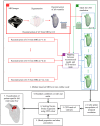Application of Patient-Specific Computational Fluid Dynamics in Coronary and Intra-Cardiac Flow Simulations: Challenges and Opportunities
- PMID: 29997520
- PMCID: PMC6028770
- DOI: 10.3389/fphys.2018.00742
Application of Patient-Specific Computational Fluid Dynamics in Coronary and Intra-Cardiac Flow Simulations: Challenges and Opportunities
Abstract
The emergence of new cardiac diagnostics and therapeutics of the heart has given rise to the challenging field of virtual design and testing of technologies in a patient-specific environment. Given the recent advances in medical imaging, computational power and mathematical algorithms, patient-specific cardiac models can be produced from cardiac images faster, and more efficiently than ever before. The emergence of patient-specific computational fluid dynamics (CFD) has paved the way for the new field of computer-aided diagnostics. This article provides a review of CFD methods, challenges and opportunities in coronary and intra-cardiac flow simulations. It includes a review of market products and clinical trials. Key components of patient-specific CFD are covered briefly which include image segmentation, geometry reconstruction, mesh generation, fluid-structure interaction, and solver techniques.
Keywords: blood flow; cardiovascular; computational fluid dynamics (CFD); coronary; intra-cardiac flow simulation; patient-specific.
Figures






References
-
- Antoniadis A., Mortier P., Kassab G., Dubini G., Foin N., Murasato Y., et al. . (2015). Biomechanical modeling to improve coronary artery bifurcation stenting: expert review document on techniques and clinical implementation. JACC Cardiovasc. Interv. 8, 1281–1296. 10.1016/j.jcin.2015.06.015 - DOI - PubMed
-
- Aueron F. M., Gruentzig A. R. (1984). Percutaneous transluminal coronary angioplasty: indication and current status. Prim Cardiol. 10, 97–107.
Publication types
LinkOut - more resources
Full Text Sources
Other Literature Sources
Miscellaneous

